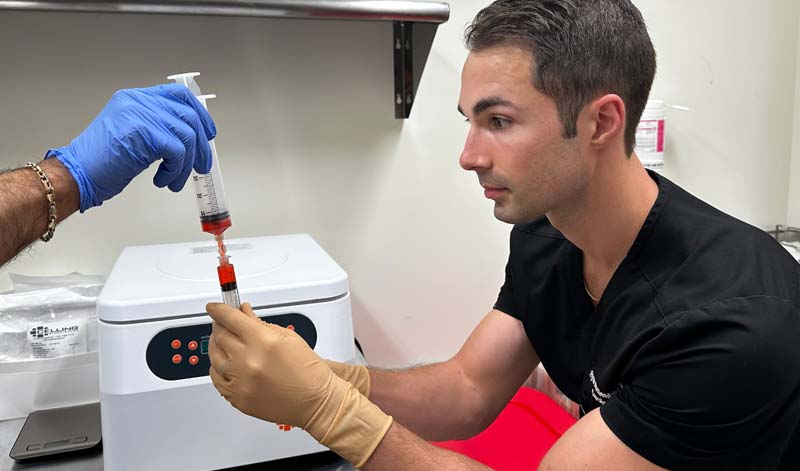
Services
Our Style of Care
When we treat you, we first establish a diagnosis by listening to and understanding your biomechanics, lifestyle, and goals.
We order and review appropriate imaging with you. We can then direct physical therapy, prescribe conscientious medication management, and consider interventional procedures to alleviate your pain.

What We Treat
-
Osteoporosis
A bone disease characterized by decreased bone density and strength, leading to fragile bones that are more prone to fractures.
-
Degenerative Disc Disease
A condition caused by the wear and tear of spinal discs, leading to pain, weakness, or numbness.
-
Herniated Disc
Occurs when the soft inner portion of a spinal disc protrudes through a tear in the tougher outer layer, potentially causing pain and nerve irritation.
-
Vertebral Compression Fractures
Fractures in the vertebrae of the spine, often caused by osteoporosis, leading to severe back pain.
-
Facet Joint Pain
Pain stemming from the facet joints in the spine due to arthritis, injury, or stress, causing stiffness and discomfort.
-
Sciatica
Pain that radiates along the path of the sciatic nerve, from the lower back through the hips, down each leg, often due to a pinched nerve.
-
Spinal Stenosis
A condition where the spinal column narrows, putting pressure on the spinal cord and nerves, causing pain or numbness.
-
Spondylolisthesis
A condition where a vertebra slips forward over the one below it, causing lower back pain and, in severe cases, nerve compression.
-
Sacro-Illiac Joint Dysfunction
Pain and dysfunction in the sacroiliac joints, where the lower spine and pelvis connect, leading to pain in the lower back and legs.
-
Whiplash
A neck injury due to forceful, rapid back-and-forth movement of the neck, like the cracking of a whip, often resulting from rear-end car accidents.
-
Cervicogenic Headaches
Headaches originating from the cervical spine or base of the skull, often accompanied by neck pain.
-
Osteoarthritis of Peripheral Joints
A degenerative joint disease affecting the cartilage of the body’s peripheral joints, causing pain and stiffness.
-
Myofascial Pain
Pain and tenderness in the body’s muscles and the fascia (connective tissue) surrounding them, often due to repetitive strain or muscle injury.
-
Peripheral Neuropathy
Damage to the peripheral nerves outside the brain and spinal cord, resulting in weakness, numbness, and pain, typically in the hands and feet.
-
Failed Back Surgery Syndrome
Persistent pain following one or more spinal surgeries, often involving continued pain at the site of the surgery.
-
Coccydynia
Pain in the coccyx or tailbone area, especially when sitting or with any activity that puts pressure on the bottom of the spine.
Interventional Services
-
Osteoporosis Evaluation and Management
This involves assessing bone density to diagnose osteoporosis and implementing treatment plans that may include medication, lifestyle changes, and dietary modifications to improve bone health and reduce fracture risk.
-
Cervical, Thoracic, Lumbar, Sacral Transforaminal Epidural Steroid Injections
These are targeted injections of steroids into the epidural space of the spine to reduce inflammation and pain in the cervical, thoracic, lumbar, or sacral regions.
-
Facet Joint Injections via Medial Branches and Radiofrequency Ablation of the Facet Joints
Involves injecting local anesthetic and steroids into the facet joints or using radiofrequency waves to disrupt nerve function, aiming to relieve chronic back pain caused by facet joint problems.
-
Sacroiliac, Hip, and Shoulder Injections
Steroid or anesthetic injections into the sacroiliac, hip, or shoulder joints to reduce inflammation and alleviate pain in these areas.
-
Sciatica – (“pinched nerve” – radiating arm and leg pain)
Sciatica refers to pain that travels along the path of the sciatic nerve, which extends from the lower back down through the legs, often resulting from nerve compression.
-
Peripheral Joint Injections, Trigger Point Injections
These involve injecting medication directly into joints or trigger points (tense muscles) to relieve pain and reduce inflammation in peripheral joints.
-
Kyphoplasty
A surgical procedure aimed at relieving pain and restoring the height and angle of a vertebra that has been fractured or collapsed due to osteoporosis, involving the insertion of a balloon into the vertebra followed by cement to stabilize the structure.
-
Discography
An imaging test that involves injecting a dye into the soft center of a disc in the spine to diagnose the source of back pain, usually before spinal fusion surgery.
-
Lumbar Percutaneous Disc Decompression
A minimally invasive procedure that reduces pressure from herniated discs in the lumbar spine, often using techniques like nucleoplasty or annuloplasty to relieve pain.
-
Spinal Cord Stimulator Trials
A trial period where a device is temporarily implanted to send electrical signals to the spinal cord to determine if permanent implantation could effectively manage chronic pain.
-
Ultrasound Musculoskeletal
A diagnostic imaging technique that uses sound waves to produce images of muscles, tendons, ligaments, and joints throughout the body, aiding in the diagnosis of musculoskeletal conditions.
-
EMG/Nerve Conduction Studies
Electromyography (EMG) and nerve conduction studies measure the electrical activity of muscles and the speed of nerve signals, respectively, to diagnose neuromuscular disorders and nerve damage.
-
PRP - Platelet Rich Plasma Therapy
A treatment that involves injecting a concentration of a patient’s own platelets to accelerate the healing of injured tendons, ligaments, muscles, and joints. By utilizing the body’s natural healing processes, PRP therapy can enhance tissue regeneration and repair, potentially reducing the need for medications or surgeries.
